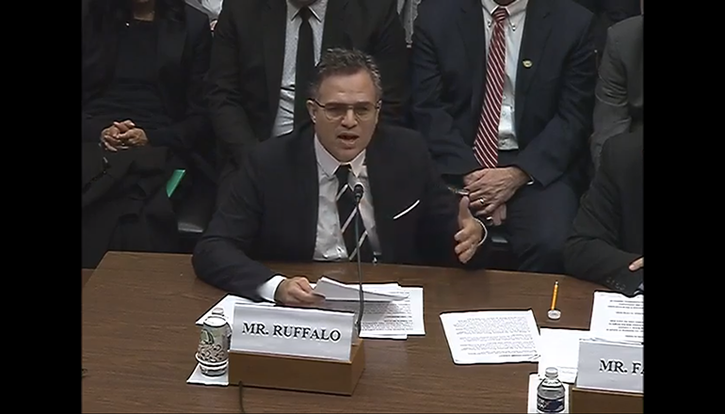A new movie is bringing more focus to the potential impacts of PFAS, but industry experts and federal regulators are waiting on advanced scientific research.
The issue around per- and polyfluoroalkyl substances (PFAS) is a fast-moving topic with even slower-moving regulatory action. Now, a new movie, “Dark Waters,” featuring actor and activist Mark Ruffalo, is bringing even more focus to the human health and environmental problems associated with these “forever chemicals.”
The problem, however, is there are thousands of widely used PFAS compounds with varying carbon chains found in the everyday products we all use and rely on. There also is a void of updated scientific research, leaving experts in the solid waste industry with seemingly more questions than answers.
Light has been shone on two of the more infamous PFAS compounds: perfluorooctanoic acid (PFOA) and perfluorooctane sulfonate (PFOS), which have been voluntarily phased out across the globe over the last two decades. They are the compounds typically referred to when discussing health implications related to liver disease, kidney cancer, high cholesterol, thyroid function, elevated liver enzymes and testicular cancer.
At the federal level, the House Committee on Oversight and Reform just held its fourth public hearing calling for a need for federal action on PFAS. During that hearing, Ruffalo, a key witness, testified about the dangers of PFAS contamination on human health and the environment. In the new film “Dark Waters,” Ruffalo plays attorney Robert Bilott, who testified before the subcommittee in September. Bilott defended thousands of plaintiffs in Parkersburg, W.Va., against DuPont de Nemours, Inc., a chemical manufacturer that allegedly knowingly contaminated the groundwater in Parkersburg with PFAS compounds and spent decades covering it up.

The subcommittee met again on November 19 to urge the Trump administration and U.S. Environmental Protection Agency (EPA) to regulate and clean up existing PFAS contamination in heavily impacted areas.
“The Environmental Protection Agency needs to set maximum contaminant levels under the Safe Drinking Water Act, not just for the two most notorious types of PFAS chemicals, PFOS and PFOA, but for PFAS as a class—a class of more than 5,000 different man-made chemicals,” said Subcommittee on Environment Chairman Harley Rouda during the hearing. “And DOD [the U.S. Department of Defense] needs to commit to cleaning up contamination around military sites expeditiously and work with the urgency this crisis demands to find an alternative to the PFAS-containing firefighting foam used in training exercises.”
EPA has developed a 72-page “PFAS Action Plan” outlining the steps it is taking to address PFAS. The plan describes EPA’s approach to identifying and understanding PFAS, approaches to addressing current PFAS contamination, preventing future contamination and communicating with the public about PFAS. According to EPA, the plan also describes broad actions EPA has underway to address challenges with PFAS in the environment, including next steps on the following four PFAS management actions:
Initiating steps to evaluate the need for a maximum contaminant level for PFOA and PFOS.
Beginning the necessary steps to propose designating PFOA and PFOS as “hazardous substances” through one of the available federal statutory mechanisms.
Developing groundwater cleanup recommendations for PFOA and PFOS at contaminated sites.
Developing toxicity values or oral reference doses for GenX chemicals and perfluorobutane sulfonic acid.
On November 25, EPA asked the public for input on potentially adding certain PFAS compounds to the list of chemicals companies are required to report to the agency as part of the Toxics Release Inventory (TRI).
“EPA continues to show critical leadership on addressing PFAS as we aggressively implement our PFAS Action Plan—the most comprehensive cross-agency plan to address an emerging chemical ever taken by EPA,” said EPA Administrator Andrew Wheeler in a statement. “I started at the agency as a career employee in the TRI program and exploring the addition of certain PFAS chemicals to the TRI is an important step that can enhance this tool and provide important information to the public on these chemicals for the first time.”
TRI will provide the public with information about the use of certain chemicals by tracking their management and associated activities. U.S. facilities in different industry sectors must report annually how much of each chemical is released to the environment and/or managed through recycling, energy recovery and treatment. Currently, no PFAS chemicals are included on the list of chemicals required to report to TRI.
As EPA considers whether to add these chemicals to TRI, the agency will use public comments and information received in response to the Advance Notice of Proposed Rulemaking (ANPRM) for two purposes. First, the public input will help the agency determine whether data and information are available to fulfill TRI’s chemical listing criteria. Second, EPA will use the input to help evaluate the extent and usefulness of the data that would be gathered under TRI.
All comments and information received in response to this ANPRM will be evaluated along with previously collected and assembled studies. If EPA decides to move forward with adding PFAS chemicals to TRI, the agency will publish a proposed rule and seek public comment on the proposal.
What Does This Mean for Solid Waste?
Bryan Staley, president and CEO of the Environmental Research & Education Foundation (EREF), told Waste360 that EPA’s PFAS Action Plan looks specifically at a maximum contaminant level now. He believes the agency is still trying to gather enough information to figure out exactly how to tackle this issue. Back in March, EREF released a request for pre-proposals targeting PFAS research and funding grants.
“There are various conversations happening around the legislative front, but different states are doing different things and they have different strategies that sometimes have different legislative outcomes,” explains Staley. “So, federal legislation would serve as a bit of a unifier of the legislation in some respects. But to me, at this point, it’s too early to tell what is going to come out of some of these oversight hearings.”
EREF’s research has focused largely on the highly contaminated sites, like military bases, and on landfill leachate. Because of the ubiquity of PFAS in society—PFAS is in 99 percent of the blood of all humans on the planet—Staley says it’s no surprise that PFAS shows up in wastewater treatment plant effluent, in surface water that ends up in drinking systems and in landfill leachate.
One of EREF’s scientific interests is to explore the level of PFAS going into the solid waste field via recycling, composting and even waste-to-energy. When recovering materials at a materials recovery facility, most likely contain PFAS, specifically for food contact paper. In addition, there has been talk of classifying PFAS substances as hazardous waste, which, if passed, would ultimately ban PFAS-containing materials from a typical Subtitle D municipal solid waste landfill.

The New Hanover County landfill in North Carolina installed a reverse osmosis system to treat PFAS.
Anne Germain, the National Waste & Recycling Association’s (NWRA) vice president of technical and regulatory affairs, points out that because many of NWRA’s members operate landfills, they are paying close attention to PFAS as a growing issue among regulators, lawmakers and the public.
“A lot of what we do is try to make sure our members are up to speed on what is going on and then develop up-to-date information on what the state of the science is,” says Germain. “One of the things we are trying to make sure people understand is that [PFAS compounds] are not all the same.”
There are at least 4,500 different types of PFAS compounds. Thus far, EPA has set health advisories for two, PFOA and PFOS. EPA is also looking to target another 75 or so compounds for further research, explains Germain.
Although landfills will come up frequently in discussion as a source of PFAS, most people are exposed to PFAS from their own homes and living their daily lives, says Germain. PFAS compounds are contained in consumer goods such as carpet, leather and apparel, textiles, paper and packaging, coatings, rubber and plastics.
“That’s one of the things we wanted to convey,” she says. “[NWRA] released an Issue Brief earlier this year to convey that. We are also trying to make sure that as the public develops more questions, we have good, factual answers on all these issues.”
“Some people conflate them all and say that they’re all the same and don’t make the distinction between them,” adds Germain. “It’s very challenging to have a conversation and to say that ‘as we look at these, we know about these two [PFOS and PFOA]. Here are the levels for these two.’ But if people start asking about all the others, it’s challenging in so many regards because there are only test methodologies for a very limited number. For instance, test methodologies for analysis just recently came out that would include looking at other sources than drinking water.”
The other thing to think about is that as a society, there are many types of goods that we purchase and use as consumers that contain PFAS, and not all of them represent a significant exposure pathway for humans, Staley points out.
“So, there is a benefit to the PFAS-containing consumer goods, depending on which ones you look at. For example, outdoor raingear, such as waterproof boots and clothing—the vast majority of those have some type of PFAS compound, which is why water sheds off the clothing,” says Staley. “From a convenience standpoint, there are a tremendous number of benefits that society reaps from these materials. For me, it becomes a question of understanding exactly how dangerous they are to us and understanding what level of risk we are willing to accept as a society. If it’s no risk, then PFAS goes away. If it’s some risk, then what is the level we’re willing to accept? To me, that’s one of the central questions around this conversation.”
EREF’s RFP for PFAS Research
To date, EREF has received a strong response to its call for pre-proposals. Within the next two weeks, the foundation will decide to fund several PFAS proposals. EREF has focused its research on PFAS treatment at the landfill level, typically leachate.
The initial push for research was to better understand how to treat these PFAS compounds because they are more challenging to treat, especially at lower levels, than standard parameters treated in leachate, explains Staley.

“The other aspect of the conversation that we want to understand from a scientific standpoint is what is the significance from an exposure pathway standpoint of PFAS as it relates to solid waste management,” he notes. “Some of the numbers out there suggest the vast majority of exposure is not from drinking water, unless it is a significantly contaminated site. So, if you’re near a firefighting training facility using foam or if you’re near a military base where there is groundwater contamination, that’s a different story.”
The numbers used, however, were calculated back when the C8 Science Panel was doing its work and research in the mid-2000s. For Staley, that raises the question: are they accurate now?
“I think it’s time for an update because a lot more has happened on the PFAS front,” he says. “The first two compounds were PFOS and PFOA, which have been voluntarily phased out, but now there are hundreds, if not thousands, more of PFAS compounds being used in commerce.”
PFAS compounds that exist range from a four-carbon chain compound to a 10-carbon chain compound. That’s important, says Staley, because different PFAS compounds behave differently.
Current research suggests that the PFAS compounds coming out of landfill leachate are shorter-chain compounds, which last in human blood for a shorter period.
“There is a complete vacuum of strong research right now in looking at exposure and health effects for these other PFAS compounds—the non-PFOA and the non-PFOS,” explains Staley. “We also need to understand the mass flow of PFAS that lead to human health exposure. In other words, are we eating more PFAS? Are we breathing more PFAS? Are we drinking more PFAS?”
“Here, to me, is kind of a big aha,” he adds. “If the truth is that we are getting a minimal exposure from drinking water, except for these highly contaminated sites, and the vast majority is coming from what we eat and breathe, that is where we should be focusing the scientific research, the regulations and the attention until we can demonstrate otherwise.”
In addition to funding, EREF has developed a compendium of all the PFAS research that has been conducted, specifically as it relates to solid waste management. It will be live on EREF’s website in December and will continue to be a work in progress.
What to Expect from EPA
In September, EPA announced roughly $6 million to fund research by eight organizations to expand the understanding of environmental risks posed by PFAS.
EPA reports that it continues to make progress under its PFAS Action Plan. To date, the agency:
Is moving forward with the drinking water standard setting process outlined in the Safe Drinking Water Act for PFOA and PFOS.
Will propose a regulatory determination for PFOA and PFOS by the end of this year.
Is gathering and evaluating information to determine if regulation is appropriate for other chemicals in the PFAS family.
On June 10 concluded public comment on the draft Interim Recommendations for Addressing Groundwater Contaminated with PFOA and PFOS. When finalized, it will provide cleanup guidance for federal cleanup programs (e.g., Comprehensive Environmental Response, Compensation, and Liability Act (CERCLA), better known as the federal Superfund program, and the Resource Conservation and Recovery Act) that will be helpful to states and tribes.
Is initiating the regulatory development process for listing certain PFAS as hazardous substances under CERCLA. EPA said it will propose nationwide drinking water monitoring for PFAS under the next Unregulated Contaminant Monitoring Rule cycle.
Is examining available information about PFAS released into surface waters by industrial sources to determine if additional study is needed for potential regulation. EPA said it plans to develop risk assessments for PFOA and PFOS to understand any potential health impacts.
The agency also claims it is validating analytical methods for surface water, groundwater, wastewater, soils, sediments and biosolids; developing new methods to test for PFAS in air and emissions; and improving laboratory methods to discover unknown PFAS.
About the Author(s)
You May Also Like




